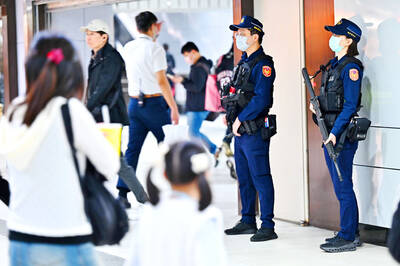Taiwan is an important contributor to the US’ strategy for a “free and open Indo-Pacific” and the US should think creatively in approaching its “non-diplomatic partnership” with Taiwan, US Assistant Secretary of Defense for Asian and Pacific Security Affairs Randall Schriver said in a keynote speech at an American Enterprise Institute event in Washington on Tuesday.
Asked about the effects the National Defense Authorization Act for next fiscal year would have on US policy, Schriver said that the US Department of Defense is examining the act to determine whether it is an endorsement for or a mandate to add new elements to existing policy.
While the act calls for hospital ship visits and exchanges between senior officials, those policies are already enabled under the Taiwan Relations Act and other legislation, he said.
Washington understands that the “sense of the Congress” resolution of the act recommends that the US firmly support Taiwan, which is consistent with US lawmakers’ position, he said.
Taiwan is democratic, well-governed, respects human rights and freedom of religion, and has been a guardian of those values in the region, Schriver said.
Taiwan has considerable experience conducting humanitarian aid and disaster relief through non-governmental organizations, he said.
Washington should think creatively to broaden US-Taiwan cooperation through unofficial channels and promote common values, he added.
Asked what has changed the most since he was US assistant secretary of defense under former US president George W. Bush, Schriver said that China has changed greatly and become more powerful, capable and determined.
However, US allies and friends have also grown in capability and willingness to play an active role in the region, including Japan, Australia and New Zealand, which have accepted their responsibility to uphold international norms and the rule of law, he said.
China’s militarization of the South China Sea is problematic and a violation of Chinese President Xi Jinping’s (習近平) promise to former US president Barack Obama, Schriver said.
Those actions are part of Beijing’s illegal territorial claims and expansion in a disputed maritime region and are damaging to the law-based international order, he said.
China has harassed other nations and made special demands on warships passing through the region, he added.
Expelling China from the Rim of the Pacific Exercise is only the first step of US countermeasures and the US Navy would “absolutely continue” freedom of navigation operations in the South China Sea, Schriver said.
More nations are to conduct freedom of navigation operations to contest the territorial claims that China has asserted over the entirety of South China Sea with its “nine-dash” line, he said.
The US has adequate satellite coverage over the region and is to publicize more information to raise international awareness, he added.
Whether US President Donald Trump’s Indo-Pacific Strategy succeeds depends on how many regional partners join the US’ cause, but Schriver said he is confident that Washington will ultimately prevail in Southeast Asia.
While China might resist in the beginning, it will eventually accept the concept of a free and open Indo-Pacific region, he said.
US officials often hear of Southeast Asian nations being unwilling to choose between Washington and Beijing, but given China’s increasingly predatory economic policies and assertive military actions, the choice is no longer that of camps, but of “distinct visions,” he said.
“The choice is between partnership or hegemony, independence or dependence, complete sovereignty or coercion, international laws and norms or unilateral claims,” he said.
Additional reporting by CNA

TRAGEDY STRIKES TAIPEI: The suspect died after falling off a building after he threw smoke grenades into Taipei Main Station and went on a killing spree in Zhongshan A 27-year-old suspect allegedly threw smoke grenades in Taipei Main Station and then proceeded to Zhongshan MRT Station in a random killing spree that resulted in the death of the suspect and two other civilians, and seven injured, including one in critical condition, as of press time last night. The suspect, identified as a man surnamed Chang Wen (張文), allegedly began the attack at Taipei Main Station, the Taipei Fire Department said, adding that it received a report at 5:24pm that smoke grenades had been thrown in the station. One man in his 50s was rushed to hospital after a cardiac arrest

SAFETY FIRST: Double the number of police were deployed at the Taipei Marathon, while other cities released plans to bolster public event safety Authorities across Taiwan have stepped up security measures ahead of Christmas and New Year events, following a knife and smoke bomb attack in Taipei on Friday that left four people dead and 11 injured. In a bid to prevent potential copycat incidents, police deployments have been expanded for large gatherings, transport hubs, and other crowded public spaces, according to official statements from police and city authorities. Taipei Mayor Chiang Wan-an (蔣萬安) said the city has “comprehensively raised security readiness” in crowded areas, increased police deployments with armed officers, and intensified patrols during weekends and nighttime hours. For large-scale events, security checkpoints and explosives

A car bomb killed a senior Russian general in southern Moscow yesterday morning, the latest high-profile army figure to be blown up in a blast that came just hours after Russian and Ukrainian delegates held separate talks in Miami on a plan to end the war. Kyiv has not commented on the incident, but Russian investigators said they were probing whether the blast was “linked” to “Ukrainian special forces.” The attack was similar to other assassinations of generals and pro-war figures that have either been claimed, or are widely believed to have been orchestrated, by Ukraine. Russian Lieutenant General Fanil Sarvarov, 56, head

PUBLIC SAFETY: The premier said that security would be tightened in transport hubs, while President Lai commended the public for their bravery The government is to deploy more police, including rapid response units, in crowded public areas to ensure a swift response to any threats, President William Lai (賴清德) said yesterday after a knife attack killed three people and injured 11 in Taipei the previous day. Lai made the remarks following a briefing by the National Police Agency on the progress of the investigation, saying that the attack underscored the importance of cooperation in public security between the central and local governments. The attack unfolded in the early evening on Friday around Taipei Main Station’s M7 exit and later near the Taipei MRT’s Zhongshan